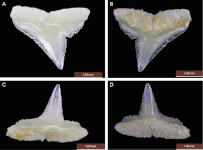Carcharhinus obsoletus
White, Kyne & Harris, 2019
Classification: Elasmobranchii Carcharhiniformes Carcharhinidae
Reference of the original description
Lost before found: A new species of whaler shark Carcharhinus obsolerus from the Western Central Pacific known only from historic records. PLoS ONE, 14(1), Article e0209387
Lost before found: A new species of whaler shark Carcharhinus obsolerus from the Western Central Pacific known only from historic records. PLoS ONE, 14(1), Article e0209387
Synonyms / new combinations and misspellings
Carcharhinus obsolerus
Carcharhinus obsolerus
Types
Carcharhinus obsoletus
Carcharhinus obsolerus
Holotype: NMW: 61463; Paratype: ANSP: 76859; ANSP: 77121;
Carcharhinus obsoletus
Carcharhinus obsolerus
Holotype: NMW: 61463; Paratype: ANSP: 76859; ANSP: 77121;
Description :
Citation: Carcharhinus obsoletus White, Kyne & Harris, 2019: In: Database of modern sharks, rays and chimaeras, www.shark-references.com, World Wide Web electronic publication, Version 05/2025
Please send your images of "Carcharhinus obsoletus" to info@shark-references.com

Carcharhinus obsoletus White, Kyne & Harris, 2019; NMW 61463, female, holotype, 433 mm TL, preserved specimen © White WT, Kyne PM, Harris M (2019) Lost before found: A new species of whaler shark Carcharhinus obsoletus from the Western Central Pacific known only from historic records. PLoS ONE 14(1): e0209387

Carcharhinus obsoletus White, Kyne & Harris, 2019; NMW 61463, female, holotype, 433 mm TL, preserved specimen © White WT, Kyne PM, Harris M (2019) Lost before found: A new species of whaler shark Carcharhinus obsoletus from the Western Central Pacific known only from historic records. PLoS ONE 14(1): e0209387
Common names
 Lost Shark
Lost Shark
 Lost Shark
Lost Shark
Short Description
Diagnose after WHITE, KYNE & HARRIS, 2019 [26921]: A small species of Carcharhinus with: a slender body and tail; no interdorsal ridge; head parabolic in dorsal view, relatively wide, interorbital space 11.2–12.0% TL; eyes relatively large, length 2.4–2.9% TL, 10.0–15.1 times in head length; no row of enlarged hyomandibular pores alongside each mouth corner; upper anterior teeth broadly triangular and serrated, with large and coarse (non-lobate) serrations basally; lower anterior teeth with narrower, mostly straight cusps; cusps of upper and lower anterolateral teeth with apical margin slightly recurved; no lateral cusplets; total tooth row counts 27–31/26–29; posterior edge of the mandibular plate with an elongate and crescentic indentation; second dorsal-fin origin well posterior of anal-fin origin, about opposite anal-fin midbase, second dorsal-fin origin to analfin origin 1.3–2.5% TL, 0.3–0.6 times second dorsal-fin base; first dorsal fin triangular, not falcate, origin about opposite first third of pectoral-fin inner margin length, free rear tip just anterior to pelvic-fin origins, length 1.7–1.9 times height, inner margin 1.9–2.5 in base; second dorsal fin much smaller than first, slightly smaller than anal fin; base 1.4–2.0 times height; height 22–31% of first dorsal-fin height; anal fin height 1.2–1.5 times second dorsal height, base 1.1–1.2 times second dorsal-fin base; total vertebral counts 114–120, monospondylous precaudal counts 36–40, diplospondylous precaudal counts 18–19, diplospondylous caudal counts 56–66, precaudal counts 54–58; no distinct black markings on fins.
Diagnose after WHITE, KYNE & HARRIS, 2019 [26921]: A small species of Carcharhinus with: a slender body and tail; no interdorsal ridge; head parabolic in dorsal view, relatively wide, interorbital space 11.2–12.0% TL; eyes relatively large, length 2.4–2.9% TL, 10.0–15.1 times in head length; no row of enlarged hyomandibular pores alongside each mouth corner; upper anterior teeth broadly triangular and serrated, with large and coarse (non-lobate) serrations basally; lower anterior teeth with narrower, mostly straight cusps; cusps of upper and lower anterolateral teeth with apical margin slightly recurved; no lateral cusplets; total tooth row counts 27–31/26–29; posterior edge of the mandibular plate with an elongate and crescentic indentation; second dorsal-fin origin well posterior of anal-fin origin, about opposite anal-fin midbase, second dorsal-fin origin to analfin origin 1.3–2.5% TL, 0.3–0.6 times second dorsal-fin base; first dorsal fin triangular, not falcate, origin about opposite first third of pectoral-fin inner margin length, free rear tip just anterior to pelvic-fin origins, length 1.7–1.9 times height, inner margin 1.9–2.5 in base; second dorsal fin much smaller than first, slightly smaller than anal fin; base 1.4–2.0 times height; height 22–31% of first dorsal-fin height; anal fin height 1.2–1.5 times second dorsal height, base 1.1–1.2 times second dorsal-fin base; total vertebral counts 114–120, monospondylous precaudal counts 36–40, diplospondylous precaudal counts 18–19, diplospondylous caudal counts 56–66, precaudal counts 54–58; no distinct black markings on fins.
Dentition
Dental meristics in the three known specimens range within 13–15 + 1 + 13–15 / 13–14 + 0–1 + 13–14, with the holotype having 14 + 1 + 14 / 14 + 1 + 14. Pronounced dignathic heterodonty between upper and lower jaws. Upper teeth broadly compressed and blade-like with semi-oblique to distally notched, oblique crowns and even labial surfaces. Lower teeth with narrow, erect, triangular crowns anteriorly, becoming oblique with slightly convex labial surfaces laterally. [26921]
Dental meristics in the three known specimens range within 13–15 + 1 + 13–15 / 13–14 + 0–1 + 13–14, with the holotype having 14 + 1 + 14 / 14 + 1 + 14. Pronounced dignathic heterodonty between upper and lower jaws. Upper teeth broadly compressed and blade-like with semi-oblique to distally notched, oblique crowns and even labial surfaces. Lower teeth with narrow, erect, triangular crowns anteriorly, becoming oblique with slightly convex labial surfaces laterally. [26921]
Remarks
shark-references Species-ID=15331; taxonomic remark: incorrect original spelling (obsolerus), changed to obsoletus (Article 32.5.1 of the Code, ICZN), see Dubois & Seret, 2019 [27434]
shark-references Species-ID=15331; taxonomic remark: incorrect original spelling (obsolerus), changed to obsoletus (Article 32.5.1 of the Code, ICZN), see Dubois & Seret, 2019 [27434]

















